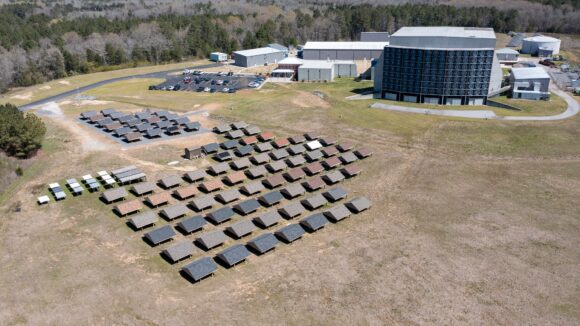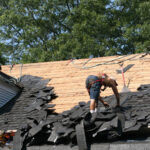I recently watched the new movie Twisters starring Daisy Edgar-Jones and Glen Powell, which gives viewers a fantastic and frightening look at the damage tornadoes and severe weather can cause to American communities. Early in the film, storm chaser/scientist Javi, played by Anthony Ramos, says the tornado-mapping technology that he and his team are creating can “change the world.”
That’s not Hollywood fiction. In many ways it is quickly becoming reality.
As Insurance Journal has reported, there is sophisticated technology that predicts storms and the damage that they can cause. Techniques that strengthen homes and businesses against those storms aren’t silver screen tropes – they’re being developed and used today at the Insurance Institute for Business & Home Safety (IBHS).
IBHS is an independent, nonprofit scientific research and communications organization supported by property insurers, reinsurers, and affiliated companies. IBHS’s building safety research leads to real-world solutions for home and business owners, helping to create more resilient communities.
I recently spent a day at IBHS’s Research Center in South Carolina and got a firsthand look at the work the team is doing to research the damage that weather events like wildfire, hail, tornadoes, hurricanes, and rain can have on a structure. IBHS has used these findings to develop the FORTIFIED construction standards, which I feel must be adopted in every community across the country to combat the ever-increasing severe weather events Americans are facing every day.
Building techniques that were developed at IBHS include FORTIFIED, a beyond-code construction and re-roofing method to strengthen properties against severe weather, and Wildfire Prepared Home, the first-ever wildfire mitigation designation program, which helps protect against embers, the leading cause of ignition during a wildfire.
Some things I learned during my trip:
- An ounce of prevention is worth a pound of cure. Some people fear the cost of protecting their homes or businesses from weather-related events. In reality, the cost to update homes to IBHS FORTIFIED standards is minimal. Re-roofing a 2,000-square-foot home to FORTIFIED typically adds an additional cost as little as $1,200. More importantly, making that initial investment can not only help prevent major damage, but can also save Americans money, frustration and heartache if and when a disaster occurs.
- Educating distribution partners and consumers is key. Most people probably don’t know that there aren’t universal, standard building codes in place. There’s a wealth of information available for both groups to learn about weather and weather-related events, building codes and why we need to strengthen them, and how they can make simple, cost-effective tweaks to make their homes/buildings safer from storms and fires. Most people trust their local building codes provide a high level of home protection, but they actually set the minimum standard and less than 35% of Americans live in areas with adopted modern building codes. IBHS research shows modern building codes save lives, reduce damage, and boost community resilience when enforced.
- We need to speak up. We’re not just trying to protect our homes and businesses; we’re also trying to protect our families and our lives. Let your local government officials know how important stronger building codes are to your communities. We’re seeing good results in communities that have modernized their building codes. For instance, the modern Florida Building Code incorporates elements of the FORTIFIED standard. After Hurricane Ian struck Florida in 2022, IBHS estimates these protections prevented $1 to $3 billion in damage to single-family homes alone.
Through August, the National Oceanic and Atmospheric Administration (NOAA) reports there have been 19 confirmed weather/climate disaster events this year alone with losses exceeding $1 billion each to affect the United States. These events included one tropical cyclone event, 15 severe storm events, 2 winter storm events and one wildfire. Overall, these events resulted in the deaths of 149 people and had significant economic effects on the areas impacted. The time for updating our building codes to align with IBHS’s FORTIFIED constructions standards is NOW. We cannot afford to wait any longer.
The life-saving research that IBHS CEO Roy Wright and his team are doing is truly changing the world and I’m grateful for their efforts. The reality is the severity of damage from Mother Nature is rising and we know how to do better.
To learn more about IBHS’s work, visit ibhs.org and to see the IBHS team in action, head to news.nationwide.com/protection. Every few weeks, we’ll be releasing a new video highlighting a different weather situation that IBHS is researching.
Photo: IBHS research facility in South Carolina, courtesy of Nationwide Property & Casualty
Topics Windstorm
Was this article valuable?
Here are more articles you may enjoy.



 Hyundai, Kia Agree to Retrofit 7 Million Vehicles to Address Theft Concerns
Hyundai, Kia Agree to Retrofit 7 Million Vehicles to Address Theft Concerns  ‘Door Knocker’ Roofers Were Everywhere. NC Farm Bureau Saw an Opportunity
‘Door Knocker’ Roofers Were Everywhere. NC Farm Bureau Saw an Opportunity  Fifth La Niña in Six Years to Disrupt Crops and Supply Chains
Fifth La Niña in Six Years to Disrupt Crops and Supply Chains  Hacking Group ‘ShinyHunters’ Claims Theft of Data From Users of Pornhub
Hacking Group ‘ShinyHunters’ Claims Theft of Data From Users of Pornhub 


